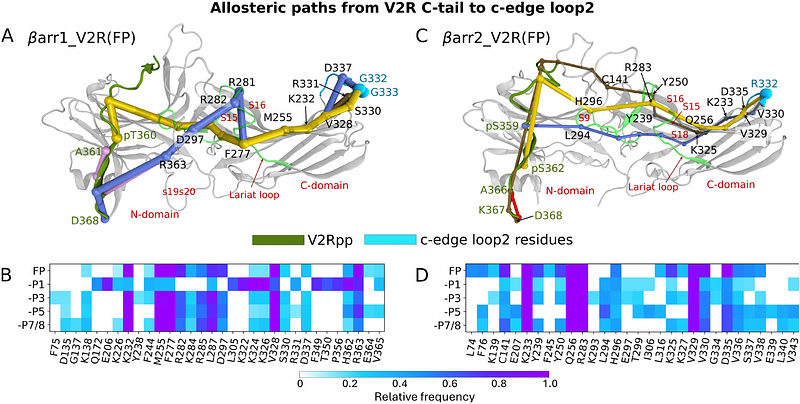Mechanistic basis for GPCR phosphorylation-dependent allosteric signaling specificity of β-arrestin 1 and 2

Mechanistic basis for GPCR phosphorylation-dependent allosteric signaling specificity of β-arrestin 1 and 2
Madhu, M. K.; Murarka, R. K.
Abstract{beta}-arrestins ({beta}arr1 and {beta}arr2) are key transducers of G protein-coupled receptor (GPCR) signaling, orchestrating both shared and isoform-specific intracellular pathways. Phosphorylation of the receptor C-terminal tail by GPCR kinases encodes regulatory "barcodes" that modulate {beta}-arrestin conformations and interactions with downstream effectors. However, how distinct phosphorylation patterns shape {beta}-arrestin structure and function remains poorly understood. Here, we combine all-atom molecular dynamics simulations with machine learning and graph neural networks to systematically map the barcode-dependent conformational landscapes of {beta}-arrestins bound to the phosphorylated vasopressin receptor 2 tail (V2Rpp). We find that V2Rpp engages {beta}arr1 more stably than {beta}arr2, mediated by isoform-specific residue contacts that trigger distinct allosteric responses. These include differential interdomain rotations and rearrangements in key structural motifs, potentially facilitating selective effector protein engagement. Furthermore, we identify critical residue networks that transmit phosphorylation signals to effector-binding interfaces in a barcode- and isoform-specific manner. Notably, {beta}arr1 exhibits stronger allosteric coupling between V2Rpp and c-edge loop 2 compared to {beta}arr2, which is consistent with its enhanced membrane association. Together, these findings advance our understanding of the molecular mechanisms by which {beta}-arrestins interpret GPCR phosphorylation signatures, offering a framework that could aid in designing pathway-selective therapeutics.